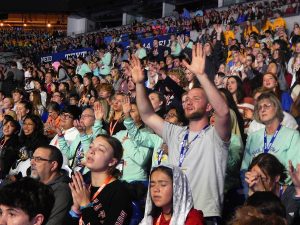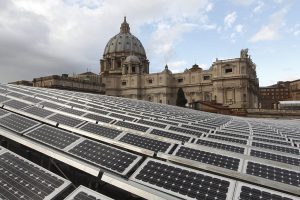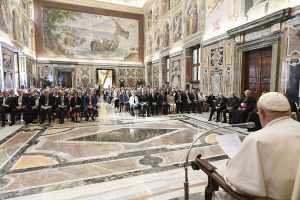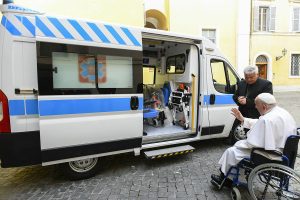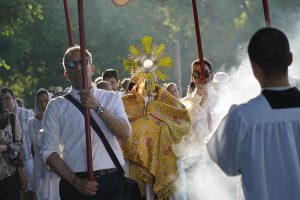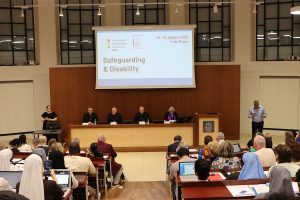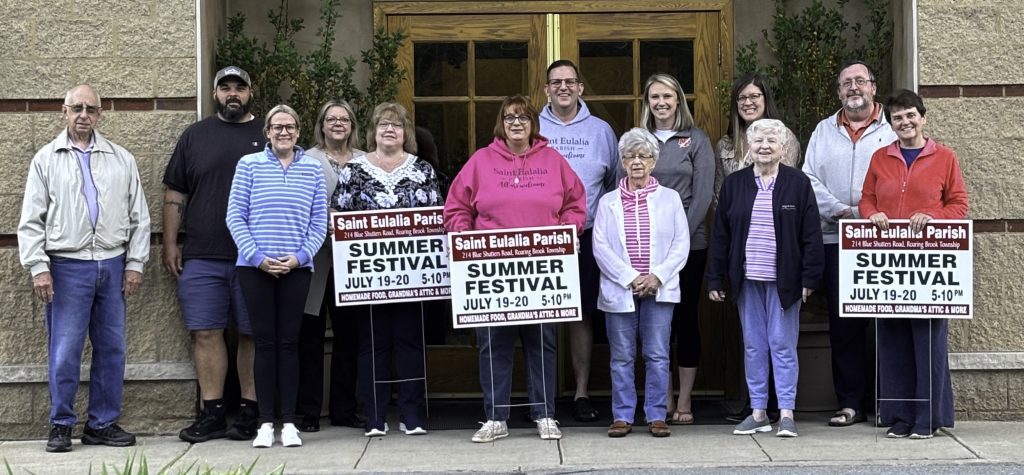(OSV News) – With less than a month to go, more than 40,000 Catholics have registered for the National Eucharistic Congress, the pinnacle of the U.S. bishops’ National Eucharistic Revival. Organizers expect the July 17-21 congress, held in Indianapolis, to be a watershed moment, igniting American Catholics’ belief in and devotion to Jesus’ real presence in the Eucharist. Here are six things to expect:
1. Lots of people.
As of late June, around 40,000 people had registered for the congress’s five-day pass, with thousands more signed up for single-day passes. That puts the congress’s attendance, especially for its weekend events, close to Lucas Oil Stadium’s 45,000-person capacity for this style of an event, said Tim Glemkowski, CEO of National Eucharistic Congress, Inc.
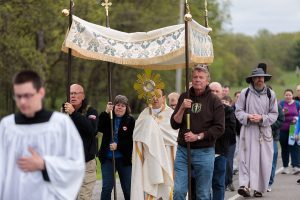
With this many people in one space — and the congress events spread over the expanse of the stadium and adjacent Indiana Conference Center — Glemkowski suggested attendees not focus on packing their personal schedules, but rather make time for rest and reflection.
“Take care of your human needs, and don’t try to overdo it,” he said. “Let the Lord lead you through an experience of a day instead of trying to maximize and be sort of everywhere.”
2. Mass, Eucharistic adoration and processions.
The Eucharist is the heart of the congress. The congress kicks off Wednesday evening July 17 with a “revival session” — the first of five, daily gatherings in Lucas Oil Stadium focused on Eucharistic adoration and worship.
Wednesday’s revival session opens with a huge Eucharistic procession that connects the National Eucharistic Pilgrimage — the eight-week, four-route pilgrimage with the Eucharist underway that culminates in Indianapolis for the congress — with the National Eucharistic Congress itself. That procession will include Bishop Andrew H. Cozzens of Crookston, Minnesota, board chairman of National Eucharistic Inc., entering the stadium with a huge monstrance.
Another major procession is planned for Saturday afternoon July 20 in downtown Indianapolis, and children who have recently made their first Communion are invited to wear their first Communion attire.
Meanwhile, Mass will be offered morning and afternoon in multiple languages. Local parishes will also host Byzantine Divine Liturgy and also Mass according to the 1962 Roman Missal (widely known as the traditional Latin Mass) on Thursday and Friday afternoons.
Throughout the congress, perpetual adoration will be held across the street from the Indiana Convention Center at the historic St. John the Evangelist Church, which Glemkowski described as the congress’s “spiritual hub.” St. John is holding evangelistic, nighttime prayer events following the congress’s revival sessions, as well as offering other forms of hospitality, including coffee and food, throughout the congress.
3. Speakers and musicians.
The congress brings together more than 50 popular Catholic speakers, leaders, media personalities and musicians under one roof for five days. Household names such as Bishop Robert E. Barron, Father Mike Schmitz and Jonathan Roumie are speaking during evening revival sessions, with Grammy-nominated musician Matt Maher leading worship on Saturday night.
Thursday, Friday and Saturday daytime schedules include “impact session” tracks and afternoon breakout sessions featuring other Catholic leaders, speakers and experts.
While many of the speakers are popular in Catholic circles, they were chosen because of their gifts in connecting a personal encounter with Jesus to mission, Glemkowski said.
“We have remarkably well known, impactful people in the church gathering for this moment,” he said. “Everyone is just trying to … lend their gifts and their support to this moment of renewal.”
The Indiana Convention Center will also offer two music stages that will feature groups such as The Hillbilly Thomists, The Vigil Project and Liveloud. A third stage is dedicated to podcasting, with shows including “Godsplaining” and “The Crunch” recording before an audience.
4. The arts and exhibits.
Also at the congress will be several exhibits related to Jesus and the saints, a musical theater performance, and programming for kids and families, as well as a dynamic expo hall.
The National Shroud of Turin Exhibit features a replica of the famous burial shroud believed to have covered Jesus in the tomb and invites viewers through a high-tech experience to consider what it terms the “world’s greatest mystery.” The Eucharistic Miracles Exhibit, originally created by soon-to-be St. Carlo Acutis (a special intercessor for the Eucharistic revival), explores Eucharistic miracles around the world. Meanwhile, a chapel with relics from Blessed Carlo and other saints associated with the revival — such as St. Manuel González García and St. Paschal Baylon — will be open for prayer and veneration.
Several exhibits and performances are geared for families. Afternoon programming includes Catechesis of the Good Shepherd atriums, which offer Montessori-style faith formation for children up to age 12, and the CatholicHOM Immersive Family Experience, which will feature an interactive puppet show.
On Thursday, “Bernadette de Lourdes, the Musical” — a theatrical performance about the Marian visionary of Lourdes, France — will be staged in Lucas Oil Stadium at 6:30 p.m. ahead of the evening’s revival session.
Meanwhile, an expansive expo hall in the convention center will be open each day with booths and displays featuring apostolates, ministries, religious orders, publishers and “makers of all types,” according to organizers.
Glemkowski likened the performances, exhibits and vendors to a town square during a festival, offering a “cultural hub” that fosters a sense of community.
“There’s a more enfleshed and embodied experience of the communion of the church that’s represented in the entire expression of the congress, that’s more than going from talk to talk to talk,” he said.
5. Service.
An encounter with the Eucharist should spur the church to seek out the “least and the lost,” Glemkowski said, which is why several outreach opportunities will be highlighted at the congress. On Thursday and Friday, attendees can pack meals for people who are hungry with the Indianapolis-based Million Meal Movement. The Denver-based Christ in the City will also train small groups of people to encounter men and women who are chronically homeless in Indianapolis.
Meanwhile, the congress includes several evangelization efforts, with evening invitations to passersby to light a candle or join adoration at St. John the Evangelist Church, and Catholics with Michigan-based St. Paul Street Evangelization prepared to share about Jesus’ real presence in the Eucharist with onlookers during Saturday’s Eucharistic procession.
Glemkowski noted that Catholic Relief Services’ staple Lenten service effort Project Rice Bowl came out of the 41st International Eucharistic Congress in Philadelphia in 1976.
“This connection between the Eucharistic heart of the church and its Eucharistic mission is very clear in these moments,” he said.
6. Commissioning.
Between a morning revival session and a closing Mass, the final day of the congress includes a “great commissioning,” which organizers compare to “a new Pentecost,” where attendees “will be sent out to joyfully proclaim the Gospel in every corner of our nation.”
That commissioning is not just for congress attendees, but for the wider church, Glemkowski said.
“The people who are gathered there at the congress are gathering on behalf of the entire people of God, the church in the United States,” he said. “The commissioning that happens at the congress is for the whole church in the United States — everybody who tunes in on EWTN or Relevant Radio, who just hears about the congress, all of us. We’re inviting a new Pentecost, to say, ‘Lord, we want to return to you with our whole hearts so that you might make us fruitful in our life as a church.'”
The congress kicks off the National Eucharistic Revival’s third and final year, the Year of Mission, where Catholics are invited to accompany Catholics no longer practicing the faith back to the church, and to grow more deeply in their understanding of what the Eucharist requires of their own lives.
The U.S. bishops’ Walk with One initiative encourages Catholics to recognize “the one person over the next year that you’re uniquely being sent to on mission,” Glemkowski said.
“It’s a small task” for an individual, he said, “but if millions of us — 5 million, 10 million Catholics — do that all together, just go accompany an individual wherever they’re at in their life, in their journey, in their story, that could be a very powerful, concrete thing we do as a church that could really change a lot of lives.”

